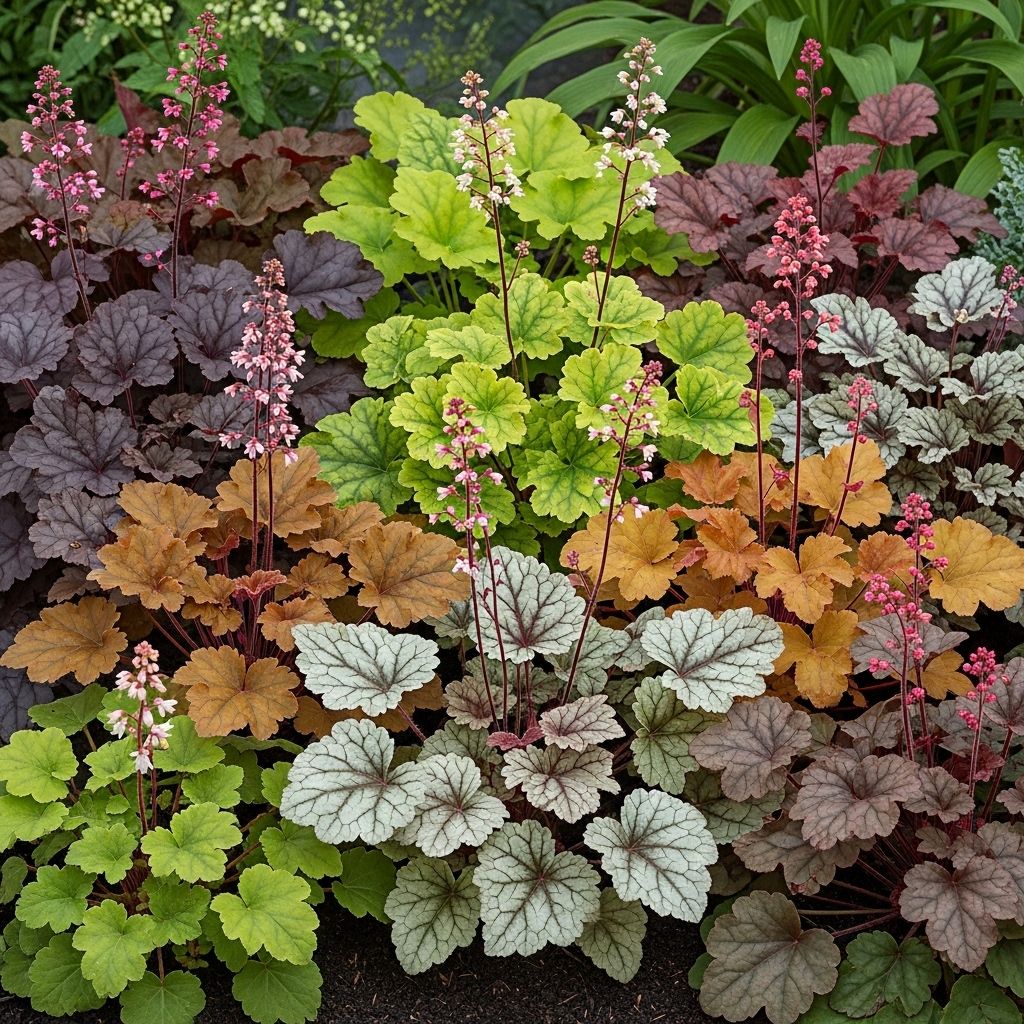31 Stunning Heuchera Varieties: A Guide to Coral Bells
Discover how diverse foliage hues can elevate shade gardens and attract pollinators.

Image: HearthJunction Design Team
31 Unique Heuchera Varieties for Every Garden
Heuchera, commonly known as coral bells, are captivating perennial plants renowned for their decorative, evergreen foliage and versatility in the garden. Native to North America, coral bells bring texture and year-round color to beds, borders, and containers, thriving in both shade and part sun gardens. This guide introduces 31 of the best Heuchera varieties, detailing their features, best uses, and aesthetic highlights to inspire your landscape design.
Why Choose Heuchera?
Heucheras are valued for more than just their blooms: their amazing foliage offers a palette of purples, silvers, reds, oranges, and greens. These resilient plants:
- Perform well in shady spots where few other perennials dazzle
- Serve as low-growing accents under trees and along pathways
- Provide habitat and food for pollinators with their summer flowers
- Require minimal care once established, making them great for low-maintenance gardens
Top Heuchera (Coral Bells) Varieties
Below is a showcase of 31 diverse coral bell varieties. Each entry includes key features to help you select the best for your garden style and growing conditions.
‘Primo Mahogany Monster’
- Zone: 4-9
- Flower Color: White
- Foliage: Deep mahogany leaves, large and bold
- Flowering Time: Summer
- Height: 1.5’
- Width: 2’
This variety stands out for its large, robust foliage—perfect for groundcover or a statement in a mixed border. The subtle white blooms appear in summer but let the bold leaves take center stage.
‘Spellbound’
- Zone: 4-9
- Flower Color: White and pink
- Foliage: Silver and purple, frosted, with ruffled leaves
- Flowering Time: Summer
- Height: 8″
- Width: 1.5’
‘Spellbound’ glimmers between bright berry purple and frosted silver shades, changing with the sun’s exposure. Ideal as a vibrant accent beneath trees or in containers.
‘Lime Rickey’
- Zone: 4-9
- Flower Color: Pale ivory
- Foliage: Bright green, ruffled leaves
- Flowering Time: Spring to summer
‘Lime Rickey’ enlivens shaded beds with its neon green leaves, contrasting beautifully against typical garden greens. Its ruffled texture adds charm to mixed plantings.
‘Black Pearl’
- Zone: 4-9
- Flower Color: White with pink calyx
- Foliage: Jet black, shiny, deeply scalloped, with rosy purple undersides
- Flowering Time: Midsummer
- Special Features: Holds dark color even in full sun
‘Black Pearl’ boasts dramatic, nearly black foliage that remains vibrant in sun and shade, ideal for bold statements in borders or modern garden designs.
Additional Standout Varieties
- ‘Lemon Love’ – Zesty yellow-green foliage for lively color spots.
- ‘Lime Marmalade’ – Brilliant chartreuse leaves, great for mixing with darker varieties.
- ‘Caramel’ – Soft apricot-caramel tones warm up cool garden beds.
- ‘Obsidian’ – Rich, glossy, near-black leaves bring a sense of depth.
- ‘Palace Purple’ – Classic and vigorous, with deep eggplant leaves, a garden staple.
- ‘Fire Alarm’ – Vibrant, fiery red leaves add hot pops of color.
- ‘Silver Scrolls’ – Silver-laced leaves over deep plum, providing unique texture and sheen.
- ‘Georgia Peach’ – Peachy-pink to rose foliage, excellent in spring and fall.
- ‘Green Spice’ – Pale green leaves with burgundy veining for a refined look.
- ‘Frosted Violet’ – Violet-purple leaves with a silvery overlay for icy drama.
- ‘Midnight Rose’ – Black leaves with pink speckles, excellent for containers and edging.
- ‘Marmalade’ – Mix of copper, gold, and amber leaves, great for warm color schemes.
- ‘Chocolate Ruffles’ – Deep brown, intricately ruffled leaves for rich borders.
- ‘Pinot Gris’ – Soft pink to silver foliage, wine-inspired for design elegance.
- ‘Solar Eclipse’ – Dark leaves with stunning lime margins for high-contrast displays.
- ‘Berry Smoothie’ – Magenta-pink leaves, perfect for spring interest.
- ‘Forever Purple’ – Electric purple ruffled leaves for year-round vibrancy.
- ‘Crimson Curls’ – Finely curled leaves in a rich burgundy color.
- ‘Paris’ – Green leaves topped with ruby pink flowers for old-world elegance.
- ‘Blondie’ – Caramel leaves with creamy yellow flowers, ideal for sunny blends.
- ‘Electra’ – Golden leaves with bold red veins, dramatic and striking.
- ‘Peppermint Spice’ – Green foliage with red veining, fresh and cool in shade gardens.
- ‘Snow Angel’ – Mottled white and green leaves brighten dark corners.
- ‘Can-Can’ – Silvery foliage with pinkish undertones and ruffles.
- ‘Silver Gumdrop’ – Metallic silver leaves and pink blooms are a showstopper in pots.
- ‘Grape Expectations’ – Bold grape-purple leaves with eye-catching gloss.
Color and Texture: The Heart of Heuchera Diversity
Few perennial genera offer as much foliage diversity as Heuchera. Their dramatic range spans:
- Purples & Plums: Bold and mysterious, perfect for moody, shaded corners.
- Coppers & Reds: Warm up cool spaces, best when mixed with greens and pinks.
- Silvers & Whites: Reflect light in dark spots and contrast dramatically against evergreens.
- Chartreuse & Yellows: Instantly brighten and enliven woodland and shade gardens.
- Bicolors & Patterns: Varieties with veins, spots, or borders stand out for textural complexity.
Best Uses for Coral Bells in the Garden
- Understory planting beneath shade trees or evergreens
- Container displays—especially mixed with hostas, ferns, or annuals
- Edging for paths and borders, due to their compact size
- Colorful groundcover, especially with larger varieties
- Contrasting foliage plant in perennial or woodland borders
- Wildlife attraction, bringing hummingbirds, bees, and butterflies
Growing and Caring for Heuchera
Heuchera are evergreen perennials from the Saxifragaceae family, thriving in USDA zones 4–9. For success:
- Exposure: Most prefer partial shade but some tolerate full sun with adequate moisture.
- Soil: Light, well-draining soil is best. Organic matter and humus-rich conditions promote lush growth.
- Watering: Moderate, keeping roots moist but not soggy. Avoid waterlogged soil which can cause rot.
- Spacing: Space plants 1–2 feet apart for optimal air movement.
- Planting Depth: To the crown—avoid burying stems as this causes rot.
- Maintenance: Remove old flower stalks and damaged leaves for continued good looks.
- Pests: Watch for black vine weevils and voles.
- Diseases: Susceptible to heuchera rust and root rot; plant in well-aerated soil to reduce risk.
Heuchera Variety Comparison Table
| Variety | Main Foliage Color | Flower Color | Size (HxW) | Best Use |
|---|---|---|---|---|
| Primo Mahogany Monster | Mahogany | White | 1.5′ x 2′ | Bold bedding or pot focal point |
| Spellbound | Silver-purple | White/Pink | 8″ x 1.5′ | Shade containers |
| Lime Rickey | Bright green | Pale ivory | 10-12″ x 18″ | Shade gardens |
| Black Pearl | Jet black | White/Pink calyx | 10-12″ x 18″ | Contrasting color in borders |
Designing with Heuchera: Tips for Stunning Combinations
- Mix leaf colors and textures—pair ruffled types with smooth, or silvers with plums for contrast.
- Use as groundcover under hosta or ferns for layered shade gardens.
- Grow in pots and raised beds for brilliant color where garden soil is not ideal.
- Contrast brights with darks to make both pop—lime with obsidian, or silver with maroon.
- Combine with other shade-lovers: Hosta, Brunnera, Tiarella, and ferns make great companions.
Frequently Asked Questions (FAQs)
Q: How much sun can Heuchera tolerate?
A: Most varieties prefer partial or dappled shade but some, like ‘Black Pearl’ and yellow-green types, tolerate full sun if soil is kept moist and cool.
(Sources )
Q: Will Heuchera attract pollinators?
A: Yes, the airy flower spikes that rise in summer bring bees, butterflies, and even hummingbirds.
(Sources )
Q: How do I prevent Heuchera root rot?
A: Ensure your soil drains well, avoid heavy clay, and never plant the crown below soil level. Raised beds and pots help.
Q: Can I grow Heuchera in pots?
A: Absolutely. They thrive in containers, provided they have rich, free-draining organic potting mix and regular water.
(Sources )
Q: What can I plant with Heuchera?
A: Shade partners like hostas, ferns, brunnera, and hellebores are perfect companions for layered texture and color.
Expert Care Tips for Lasting Garden Color
- Mulch in early spring to regulate soil temperature and moisture.
- Remove spent flower stalks to neaten appearance and encourage fresh growth.
- Divide clumps every 3–4 years to rejuvenate plants and multiply your stock.
- Feed with a balanced, slow-release fertilizer in spring.
- Protect from slugs and monitor for pests in wet conditions.
Conclusion
The diversity of Heuchera means there’s a variety for every gardener, from the collector hunting for dramatic foliage to those looking for tough, low-maintenance anchors in shady beds. By exploring their colors and features, selecting complementary companions, and following basic care advice, your garden can host a vibrant tapestry of coral bells year after year.
References
Read full bio of Shinta












